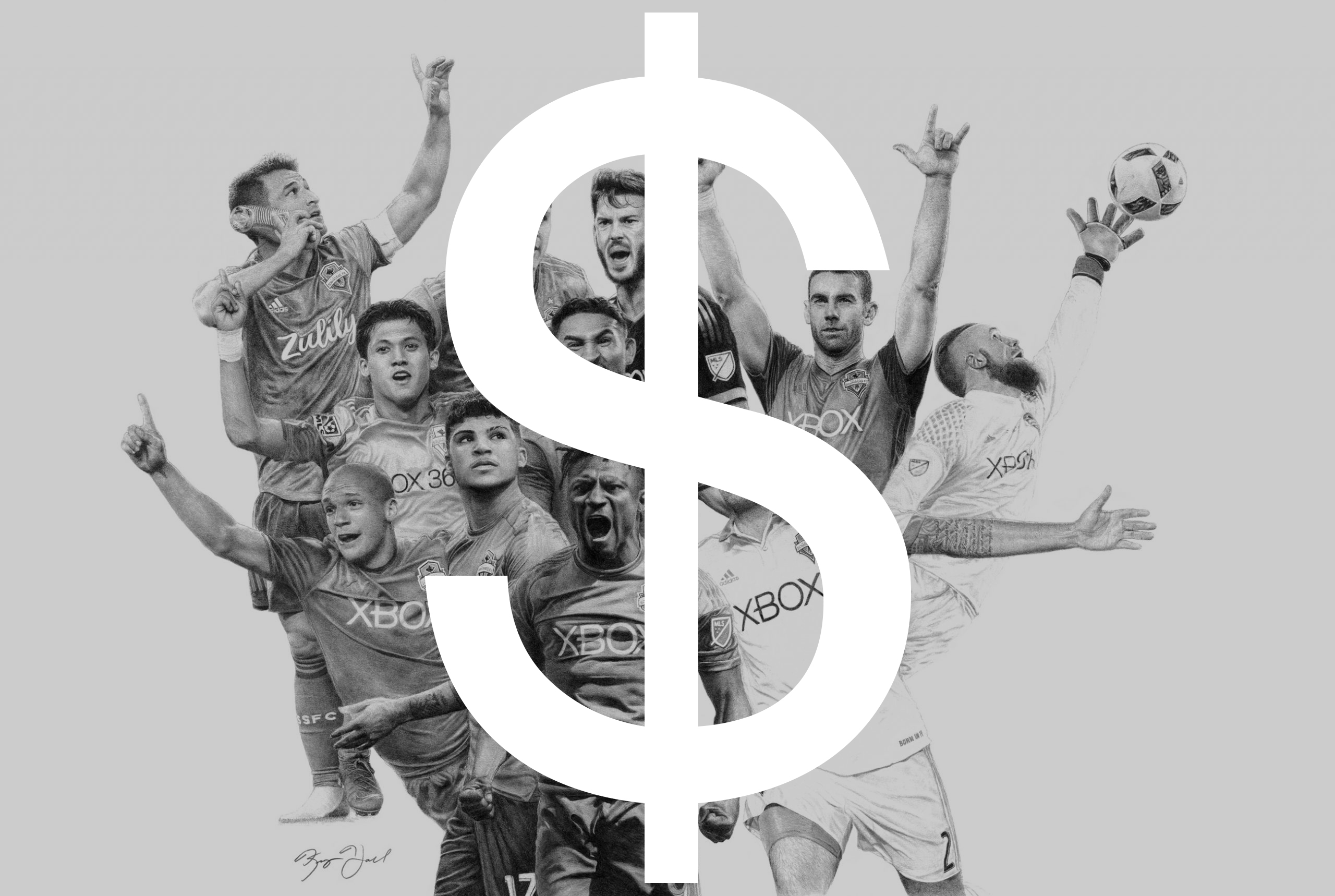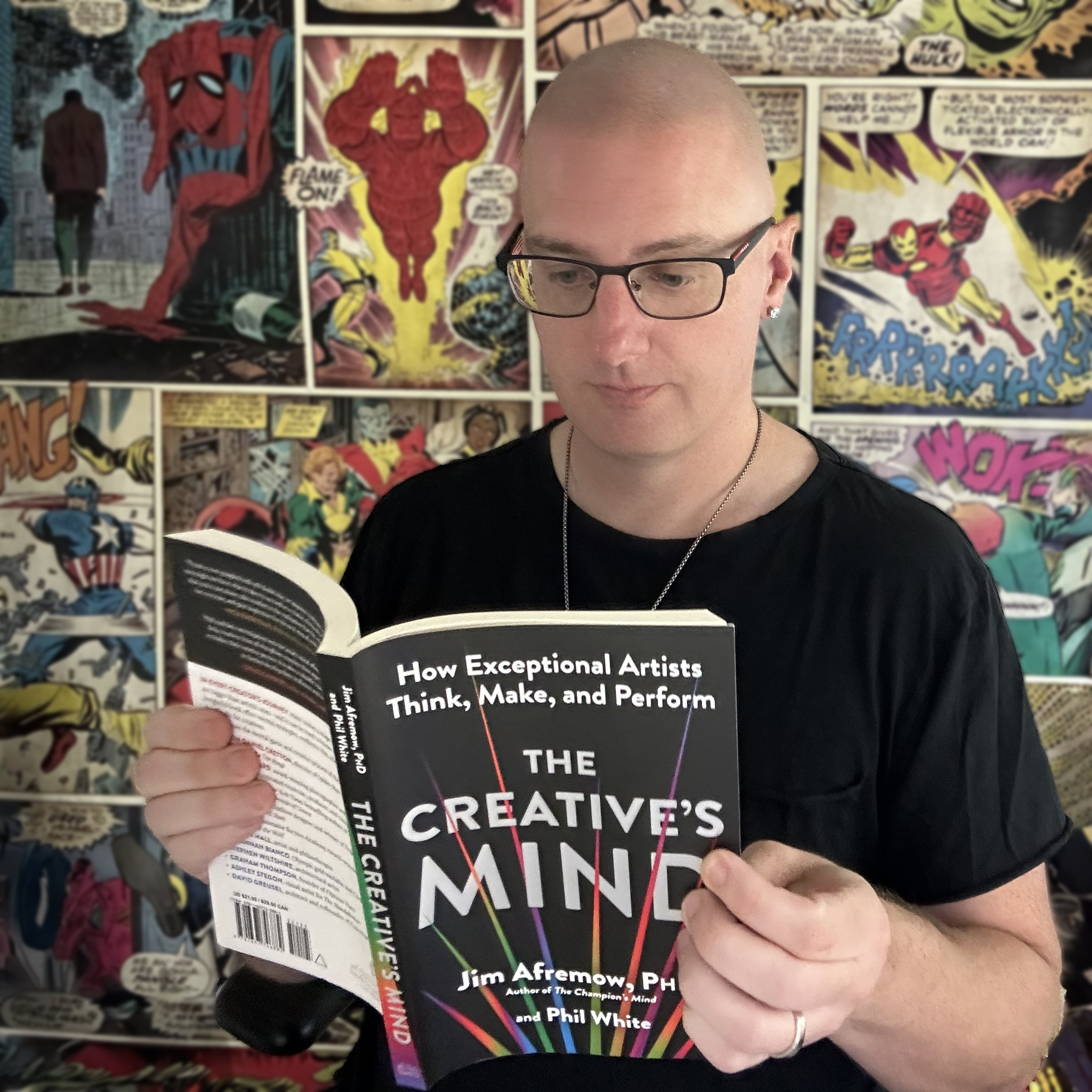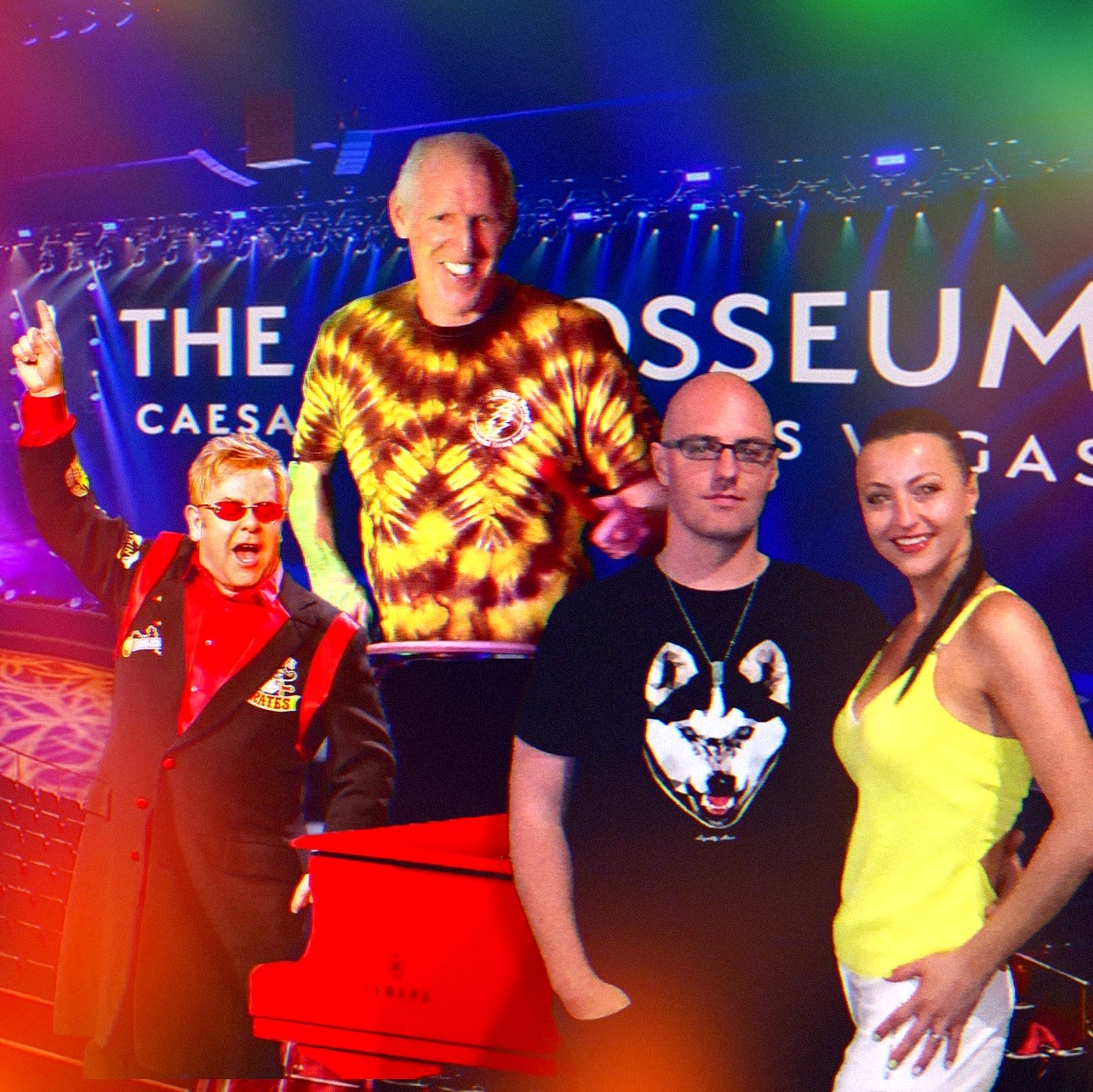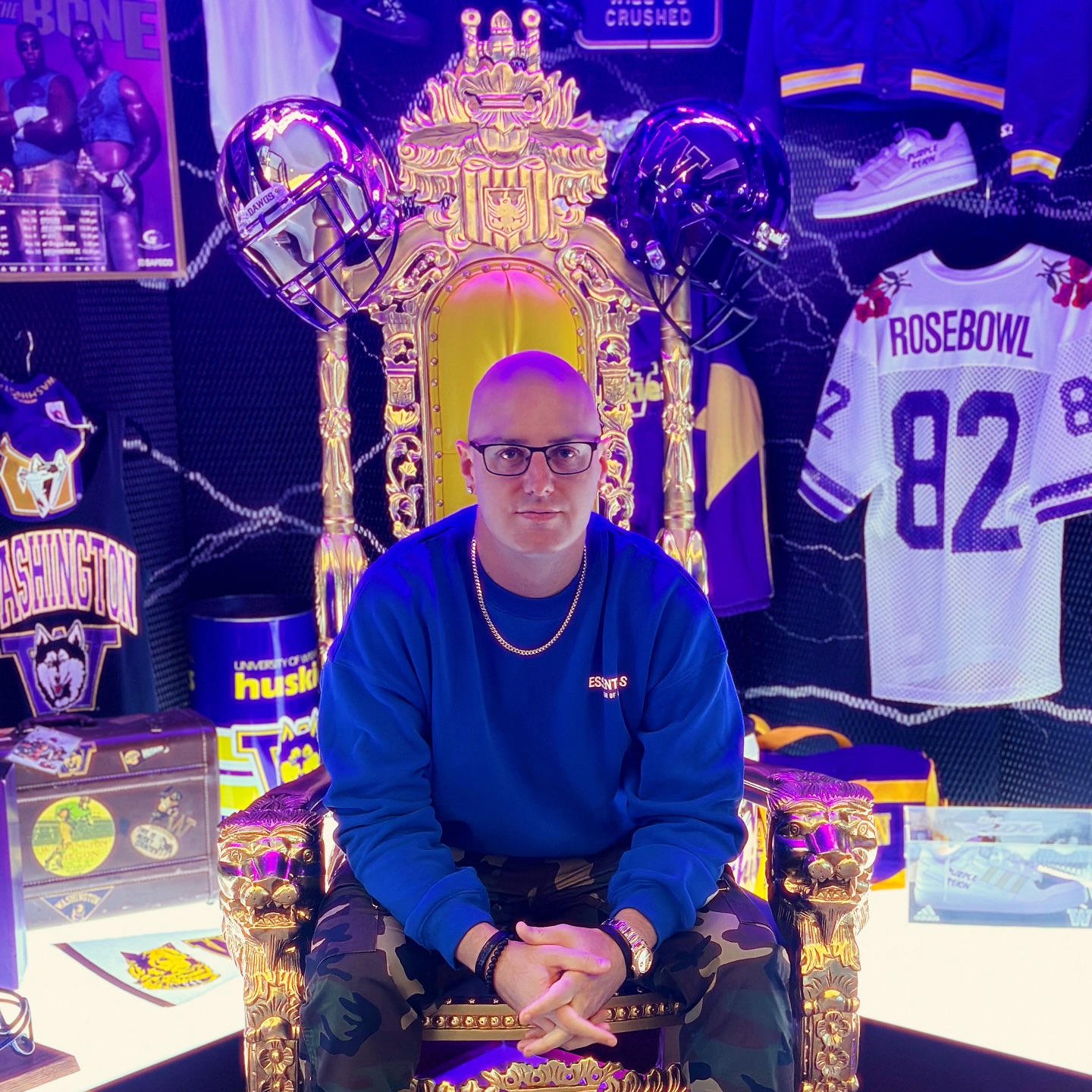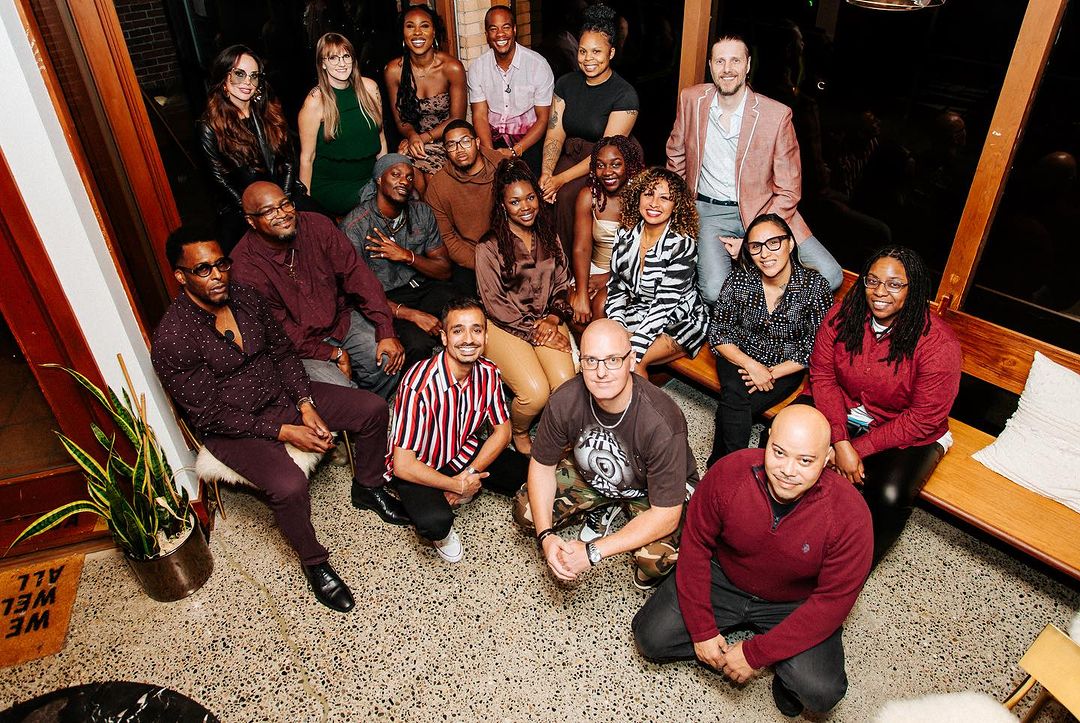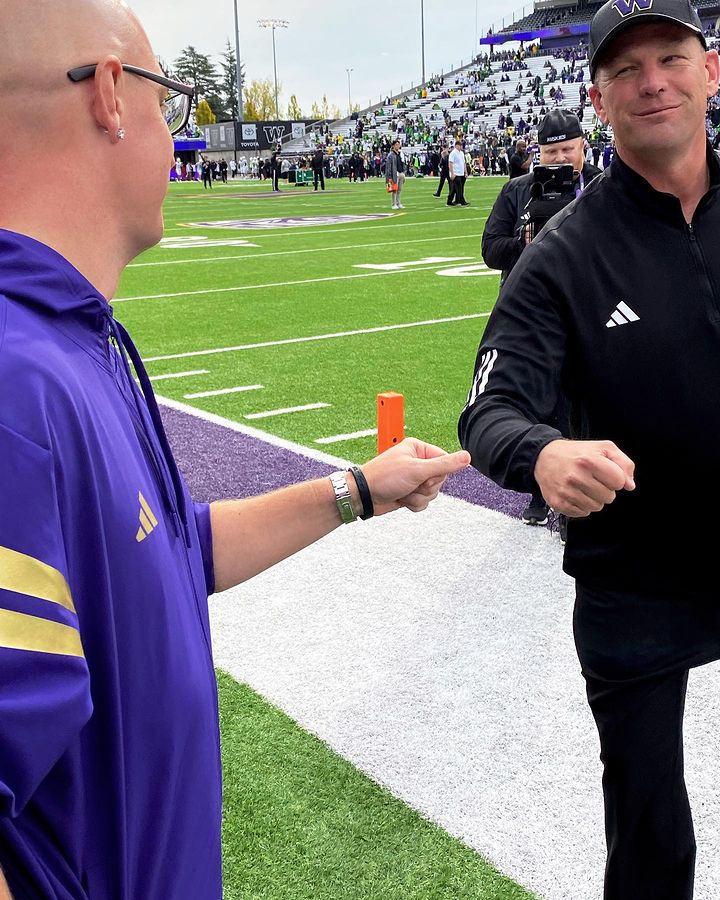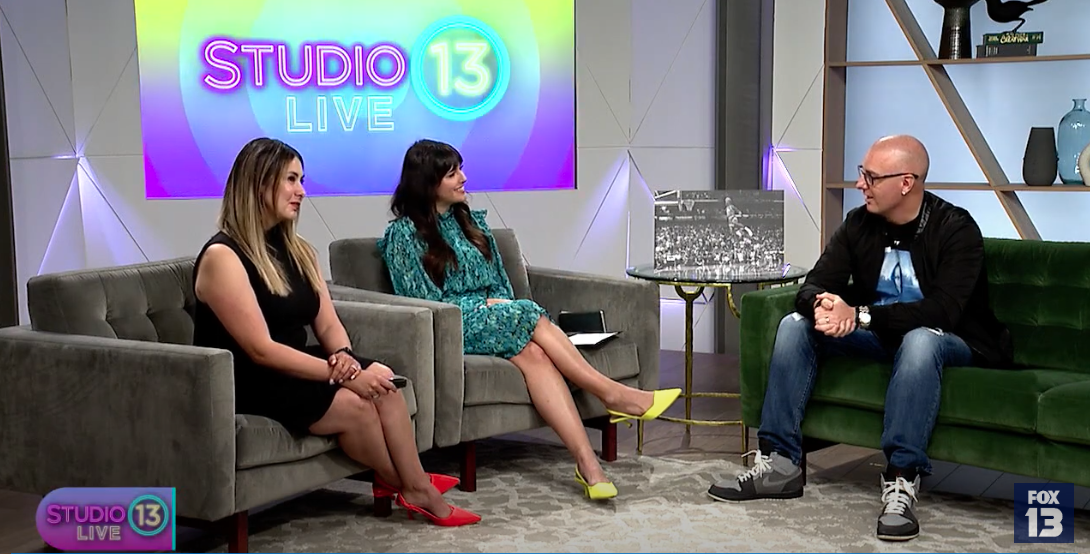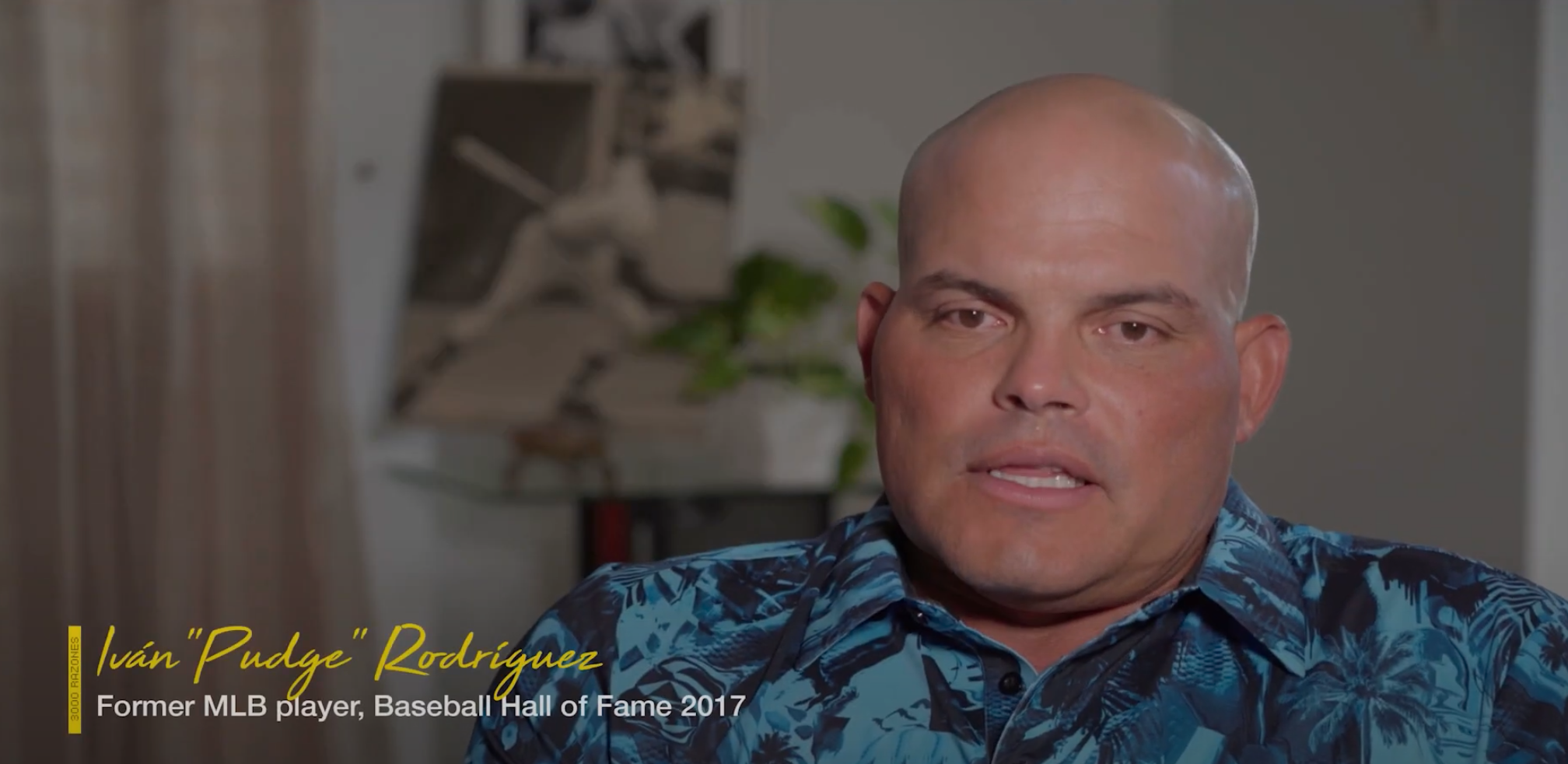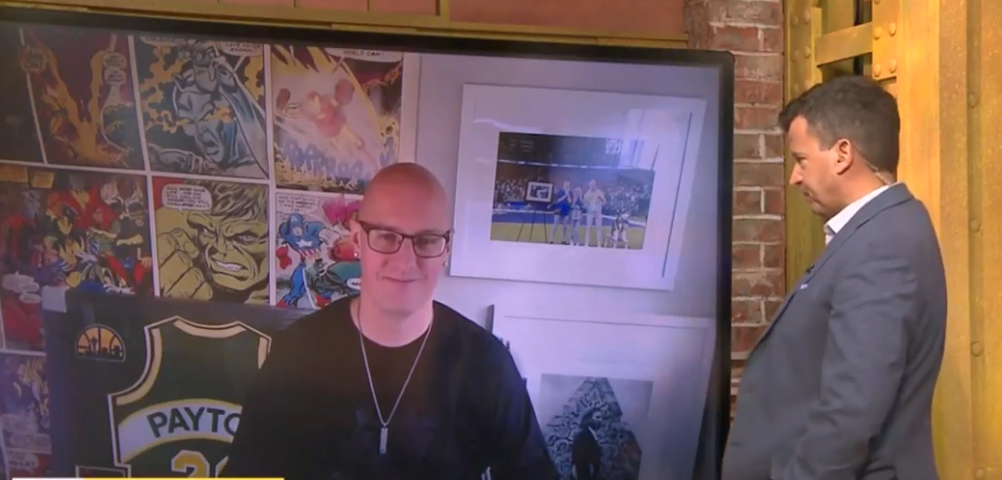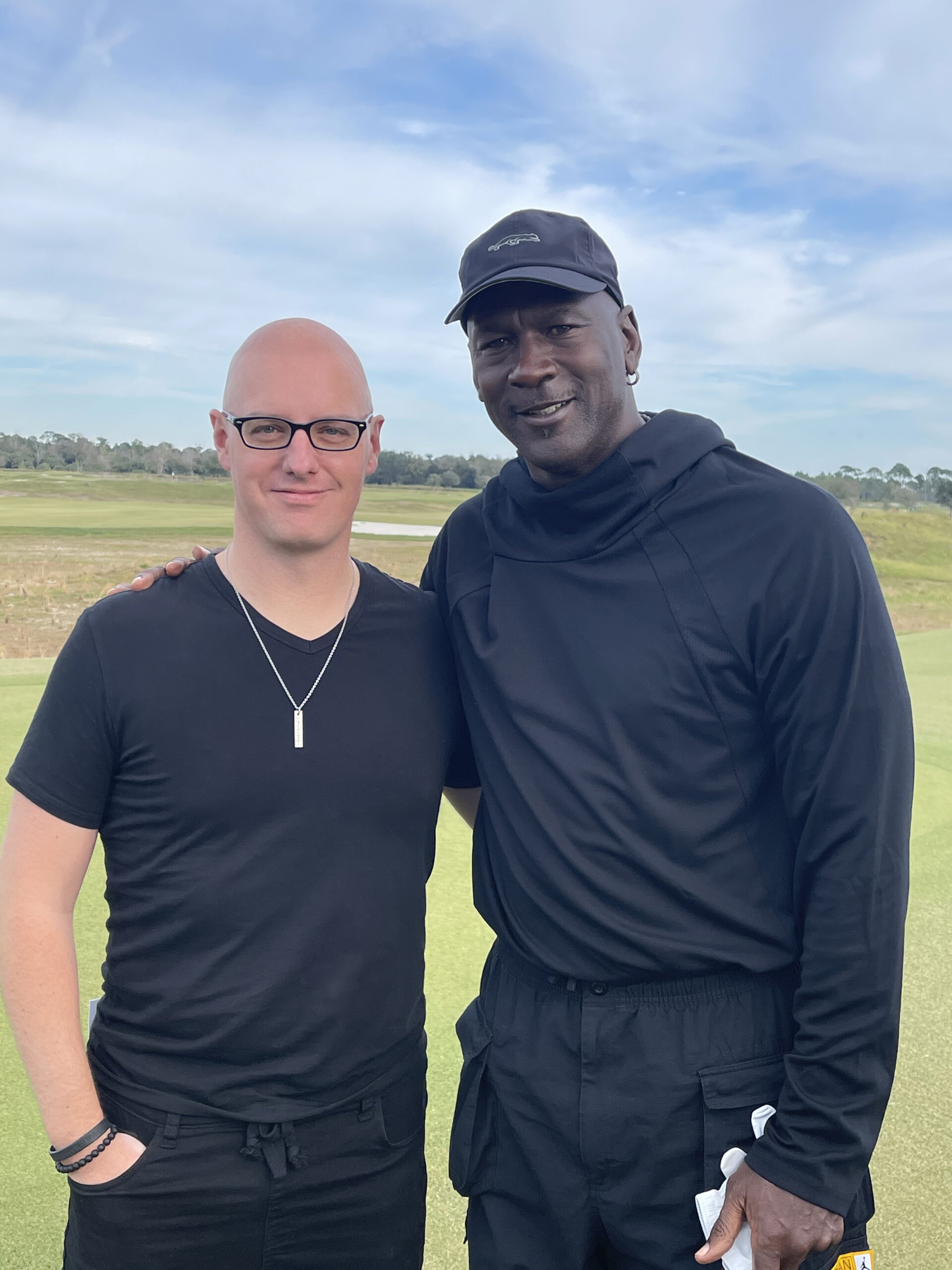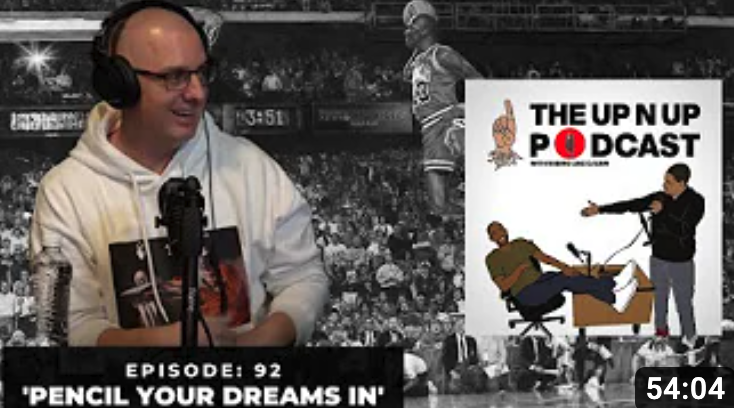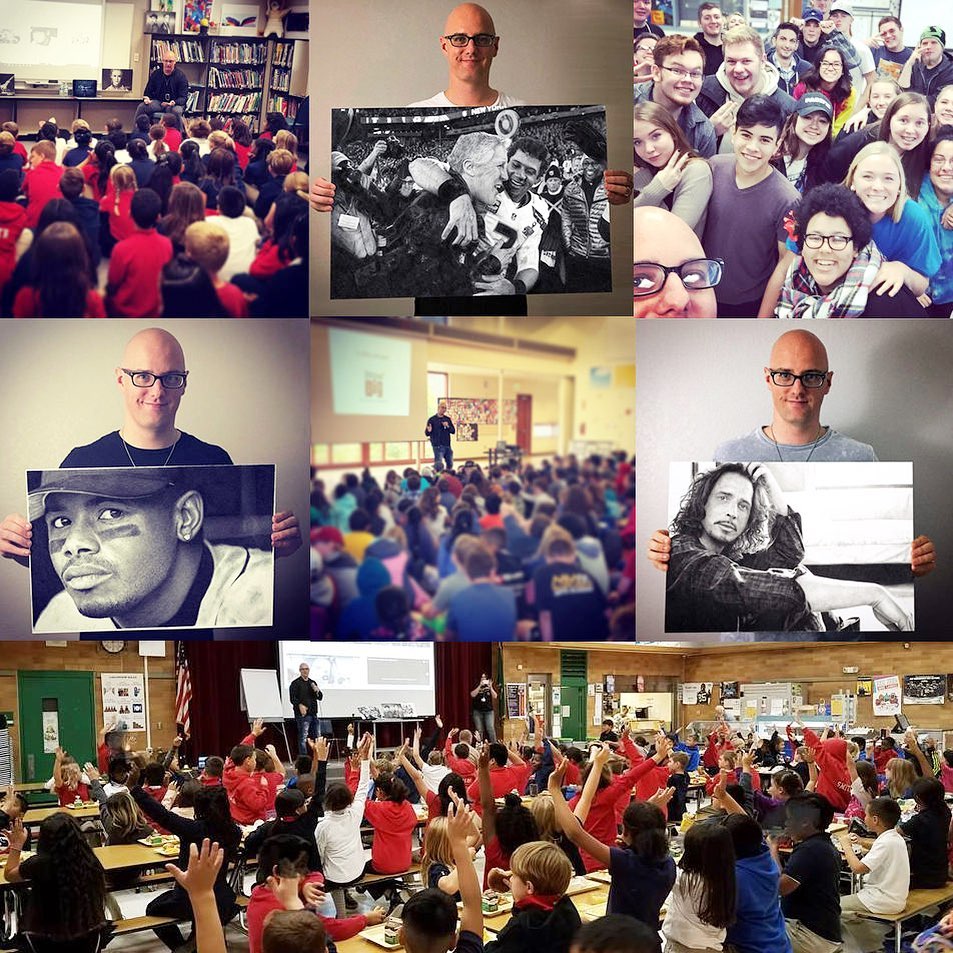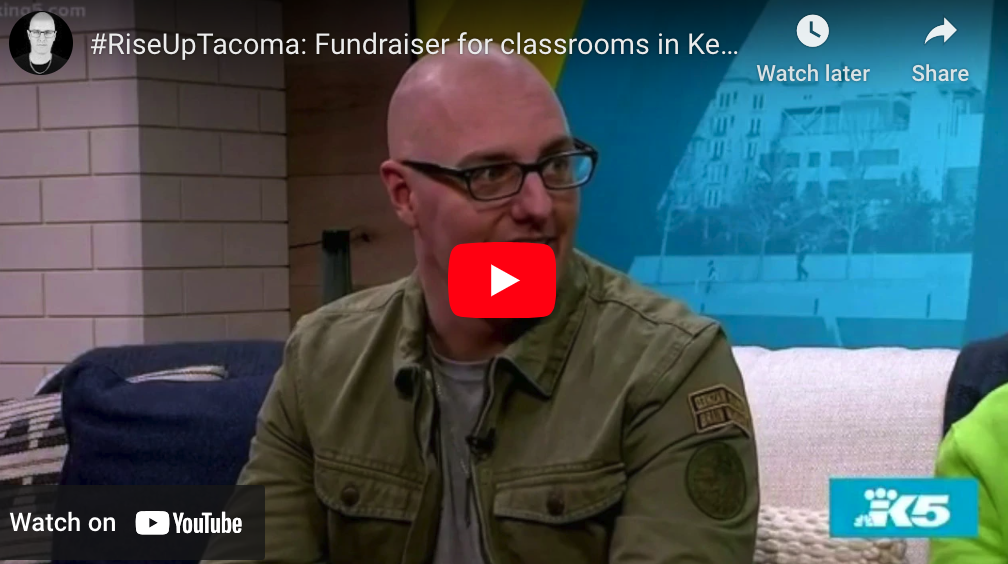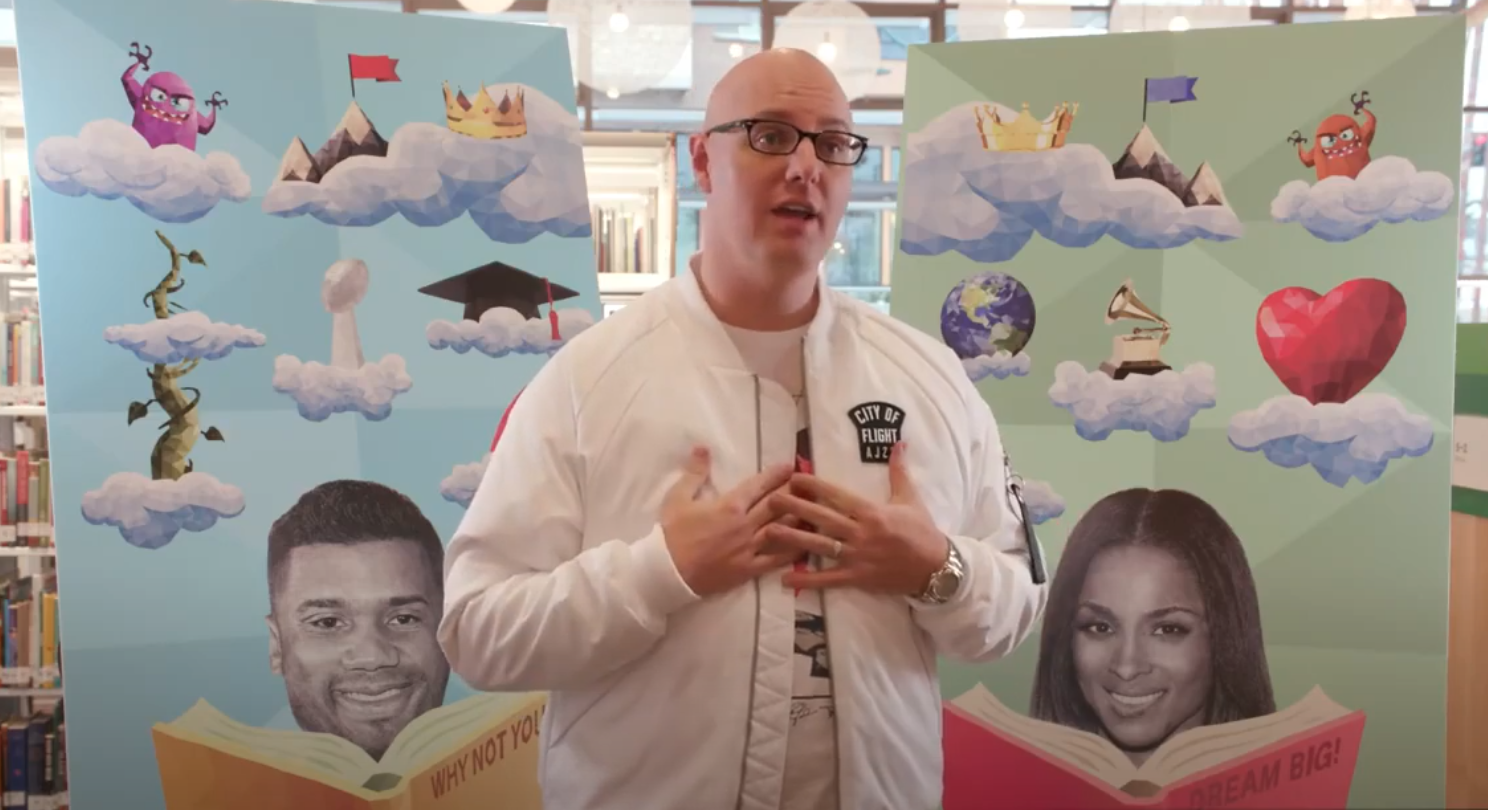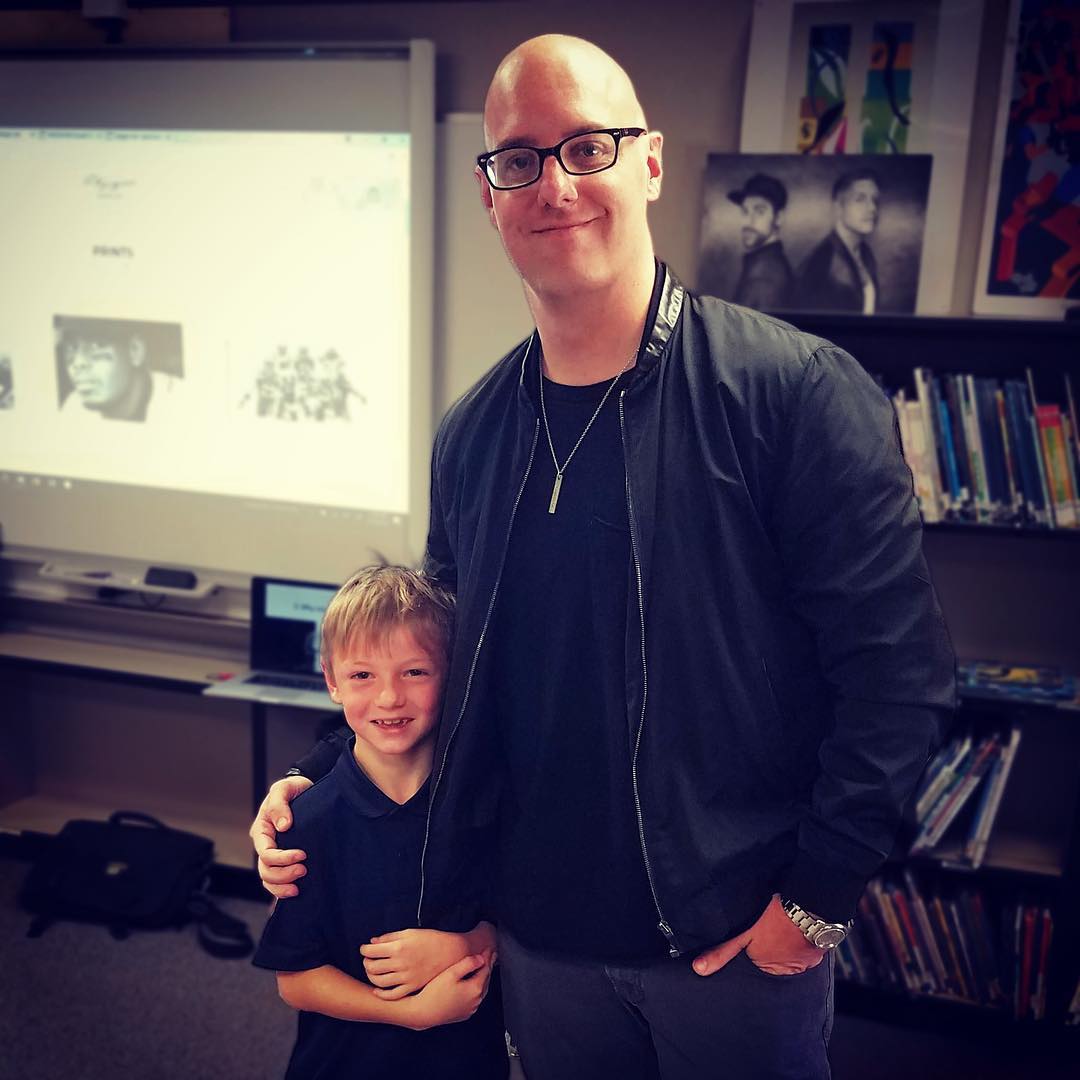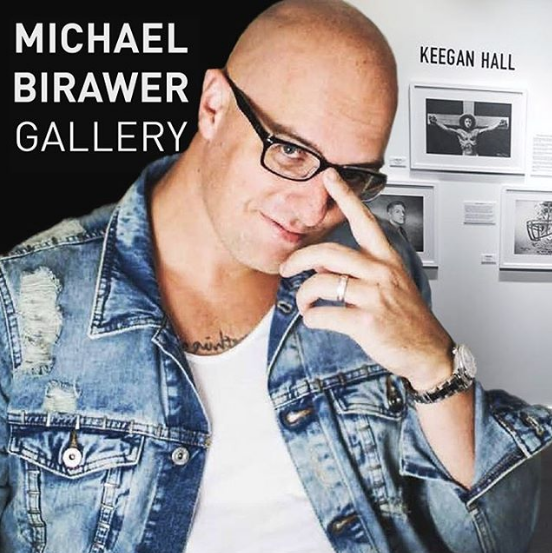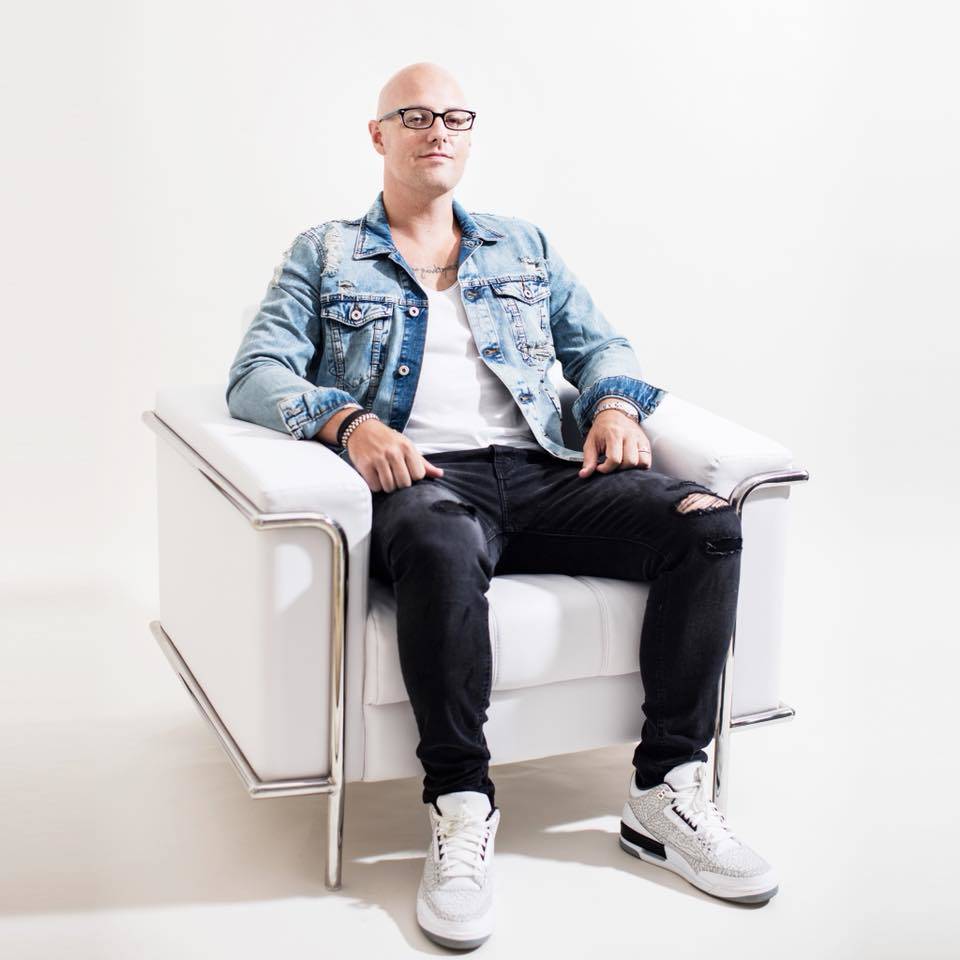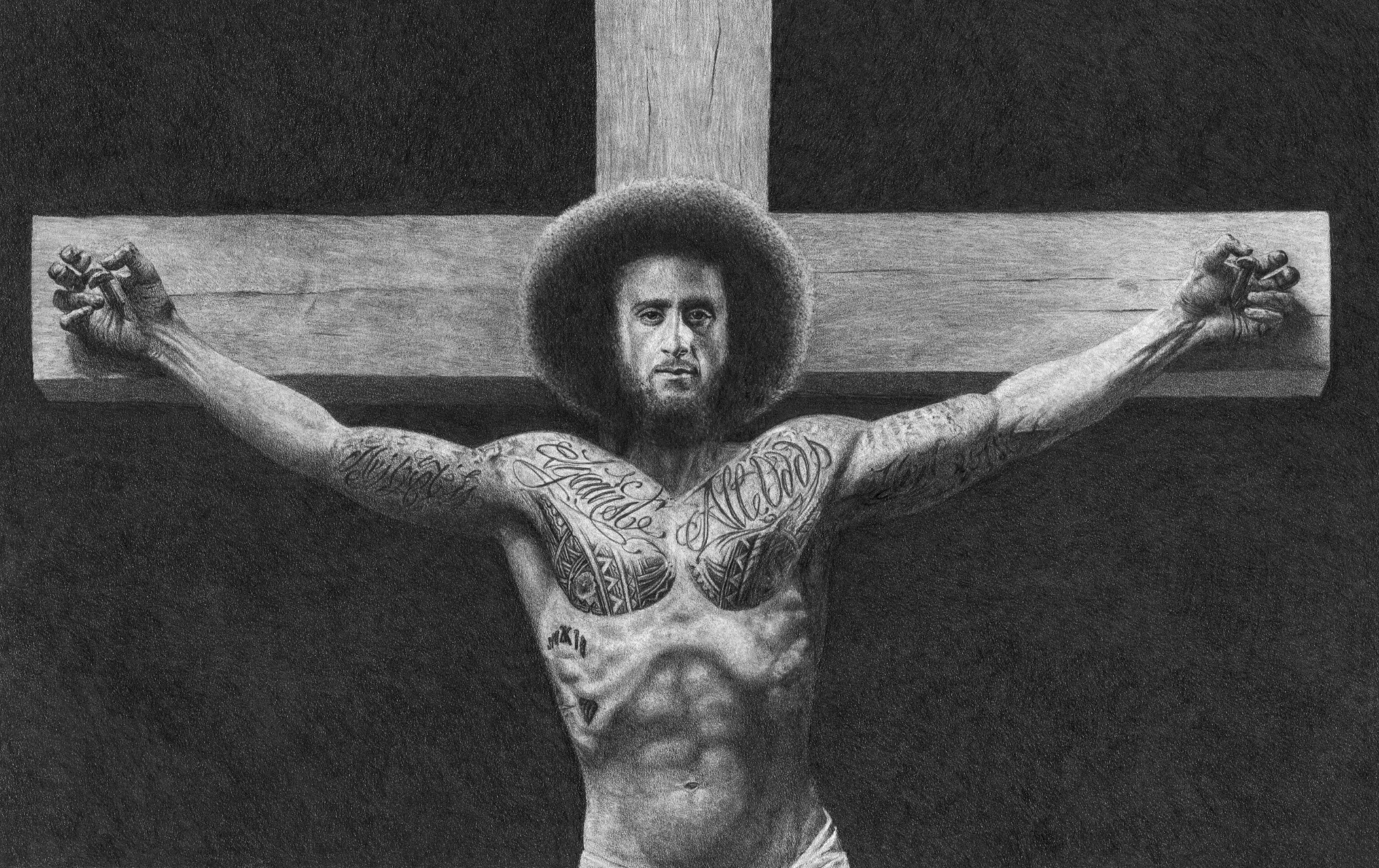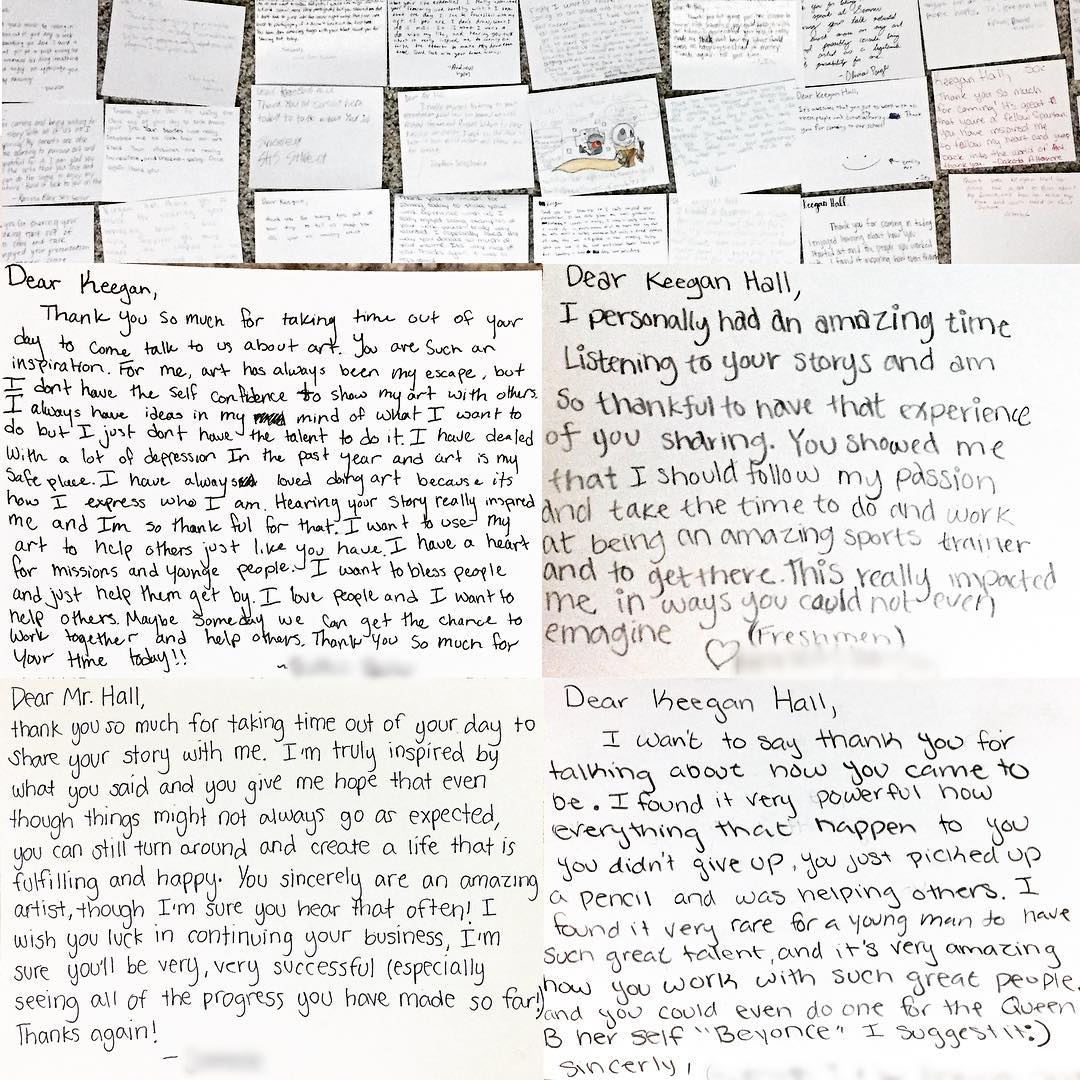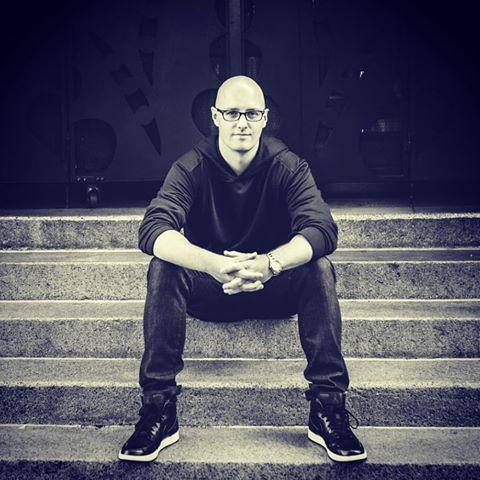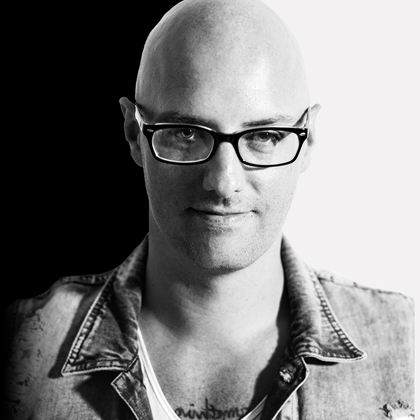
Chapter 4
WHY NOT YOU: KEEGAN HALL
The boy pulls another sheet from the stack of printer paper. With a pencil, he sketches the three panels of the comic strip, outlining his hero and villain. He sets down the pencil, grabs his markers, and fills in the boldcolors of each character. Some kids might have felt shortchanged with these inexpensive gifts. But for the young artist, these simple supplies have unlocked a whole new creative universe.
“I’m gonna come over and kill you.” The teenage girl gasped in disbelief as her uncle’s words detonated in the phone receiver. In the single-wide trailer, her young cousins cowered, sensing the tension. Joanna, born legally blind with cataracts and cerebral palsy, could feel the panic building. Keegan, who had already lost friends to addiction, now faced his uncle’s drug-fueled rage. Babysitting for Keegan and Joanna while their parents were out, the older cousin took charge. She called the cops, then grabbed the kids and dashed out the door and across the trailer park to a neighbor’s house.
Minutes later, sirens blared and blue lights flashed. Police surrounded a trailer one street over, calling for Keegan’s uncle to come out with his hands up. “They eventually got him out and took him to jail,” Keegan remembers. “That night, he hanged himself.”
CONFRONTING CHALLENGES
Traumatic experiences like these leave deep imprints on a child. However, young Keegan Hall didn’t know any different at the time. “I just thought, ‘Everyone must deal with these kinds of things,’” he said. “In some ways I’m grateful because that adversity molded me into the person I am today.” The incident with his uncle was merely one of the family issues Keegan faced growing up. His parents divorced, with his dad moving into a small travel trailer next to Keegan’s grandmother in another trailer park across town. His sister’s disabilities also drew unwanted attention.
“If we went out anywhere—like to the mall—I’d hear people talking, whispering, and looking at her,” Keegan said. “I felt like eyes were always on me, I was always uncomfortable, and I hated everything about that. Most of my life, particularly in my younger years, it felt like I was stumbling in a dark room, trying to feel my way through it, and hoping I made it to the other side somehow without something catastrophic happening. I was too afraid to ever step into the spotlight and be great because I just wanted to disappear into the background.”
To quell this sense of impending disaster, Keegan retreated into himself, seeking solace in the comic books that he bought when money allowed. At first, the original storylines of superheroes and the villains they battled were enough. But soon creativity sparked in Keegan’s brain, caught fire, and illuminated the darkness.
“I’d look at the artwork and make up my own story, in a sense, based on the images,” he said. “Then I’d make my own imagery based on these stories that I was creating in my head. That’s how I learned to draw in the early years.”
While he may not have had the luxuries that many kids take for granted, Keegan was content to continue developing his comic strips with the most basic art supplies. “I had a lot of free time, not growing up with a lot of money,” he said. “I remember for my birthday one year I got a box of white paper and crayons—that was my gift.”

DISCOVERING AN ARTISTIC PATH
In happier times, Keegan’s parents took him to their co-ed softball games and other rec league sports. While they played, he pulled out his paper and crayons and lost himself in creating. His parents had always complimented him on his drawings, but it wasn’t until other adults noticed his art that he started to believe in his talent. “I spent a lot of time drawing, and it was really powerful for me psychologically because I would get praise from people,” Keegan recalled.
When he started accompanying his parents to their Tuesday night bowling league, Keegan realized that he might be able not just to get praise for his art but also to profit from it. “I eventually figured out that I could sell some of my drawings to people there,” he shared. “Maybe they were just doing it because I was a kid, but I thought, ‘Man, I could make some extra money doing this, which is cool.’”
Not long afterward, Keegan taught himself how to stuff a Batman teddy bear for a school assignment. Captivated by a new challenge, he made a whole range of stuffed animals and started selling them to his parents’ bowling buddies for a dollar each. This early venture into entrepreneurship made him realize that his creative efforts were appreciated by others. “It reinforced this notion that I was creating something of value for people, and that added some level of self-worth,” Keegan said. These small successes helped him build much-needed confidence.
Yet although his artwork began to affirm him, Keegan remained too shy to raise his hand in class and had to overcome his natural introversion by actively joining different social circles. “Growing up, I always felt there were no kids like me,” Keegan admitted. “I wasn’t a strange kid, I don’t think, but I was quiet. I was the captain of the basketball team, so I had jock friends. There were also my art friends. I was into skateboarding too, but those friends were into drugs, and I stayed away from all that.”
Keegan became a part of these various groups, but there was nobody quite like him in any of them, sometimes making him feel like an outcast. “At least I was pretty good at these things,” he said, “so it gave me the ability to make social connections that I wouldn’t have been able to have otherwise.” Keegan used his drawing skills and comic strips as an escape from the chaos around him. But even as his abilities grew, he remained unsure of himself and was afraid to push his limits. Fortunately, his mom always believed in him and challenged him to reach his full potential. “I was this quiet, shy kid,” Keegan said. “Whenever I said something like, ‘My art’s no good. I could never…’ my mom would reply, ‘Why can’t you? Why not you? Someone’s going to do that thing. Why wouldn’t it be you?’”
As he progressed through high school, Keegan started to consider what he really wanted to do after graduation. His mom made it clear that whatever he chose, it would involve going to college so he could make a better life for himself. But did he trust her belief in him enough to make his childhood dreams into reality?
“Growing up, my dream was to become a Disney animator,” Keegan revealed. “I thought there was something so special about taking essentially nothing, a piece of paper—and in the case of animation, lots of pieces of paper—and literally bringing it to life.”
To test whether he still wanted to pursue that ambition, Keegan decided to devote himself to creating an animation for his senior project. He painstakingly drew separate frames, and once he’d put them all Why Not You: Keegan Hall 69 together at the Seattle Art Institute, a ball appeared from a blank page, grew wings, and flew around the screen. It then splashed into a pool below, after which Keegan’s head popped out of the water, and he waved at the camera.
The whole scene unfolded in just thirty seconds but took countless hours to produce. “Being part of that process and creating something that looked so simple but had an emotional component was an aha moment for me,” Keegan said. He realized the power of art to communicate without words.
With this animation, a cartoon, and several other strong pieces in his portfolio, Keegan applied to study art at the University of Washington and was accepted. But as affirming as this was for a high school grad who was unsure of himself, he still had to overcome the criticism of others that compounded his self-doubt. In an introduction to drawing class, the teacher made supportive comments about everyone’s drawings, until she got to Keegan’s self-portrait. “She shredded mine in front of everybody,” he recalled. “It was a massive blow to me as an artist and a person, and that little bit of confidence that I was gaining had just been obliterated.”
Despite the scathing review, Keegan resolved to restore his self-belief and applied for the prestigious studio art program. Not only was he accepted, but he also got to go to Rome for a semester, becoming the youngest student ever selected. “I’m used to people doubting me in every aspect of my life, and I always took that as a challenge,” Keegan said. “It pisses me off in a good way that motivates me. I decided to prove that art teacher wrong.”

OVERCOMING DOUBT WITH DETERMINATION
As he approached college graduation, Keegan faced a dilemma: turn his drawing into a career or find another path. “I had many people telling me, ‘Art isn’t a real career…you’re not that good…you’ll be poor your whole life,’ and so on,” he recalled. The seeds of negativity began to sprout, leading Keegan to make the difficult decision to give up art and follow another path.
Keegan’s first post-graduation job was a dream come true in a different way: working for his favorite NBA team, the Seattle Supersonics. Over five years, he took on various sales and marketing roles, eventually becoming the top salesperson. However, when Starbucks founder Howard Schultz sold the team to a consortium from Oklahoma City, Keegan chose not to follow. Instead, he returned to the University of Washington to earn his MBA. After graduation, Keegan combined his new knowledge with the skills he’d learned while working for the Sonics at a startup. He helped raise $4 million for a company that was later acquired and he gained real-world experience in all areas of the business. This included running the marketing department and advancing his sales expertise.
Things were going well, but disaster loomed. Keegan’s mom, who had been battling cancer, received news that the disease had returned with newfound ferocity. “We got news that the cancer had come back and were preparing to go back through the treatment process,” Keegan said. Tragically, she passed away shortly after being admitted to the hospital.
His mom’s passing rocked Keegan to his core. As he tried to make sense of this loss, he thought back to his childhood art projects and how his mom always praised, encouraged, and challenged him. One evening, he decided to pick up his pencil again and sketch a picture of his favorite basketball player, Michael Jordan. He posted it on Facebook, and people responded enthusiastically, with comments like “I didn’t even know you could draw. That’s so cool.”
One of his friends saw the post and asked if Keegan could draw his favorite football player, Kam Chancellor, offering to pay $100. Keegan was surprised and excited, thinking, “You’re going to actually give me money for a drawing? This is crazy, but okay.” He completed the drawing, posted Why Not You: Keegan Hall 71 it online, and Chancellor saw and shared it, helping Keegan gain traction quickly.
Before long, Keegan received another commission from Chancellor himself. At the time, Keegan had a minimal social media following and described himself as “just some dude who did a drawing.” However, with Chancellor’s significant audience of over half a million on Twitter (now X), each project update brought more attention to Keegan’s work.
Realizing the potential, Keegan decided to provide his growing fan base with a way to purchase his prints. He learned to code and created his own website. Reflecting on this, he said, “It seemed silly at the time because there was only one thing people could buy.”
As Keegan opened up a new revenue stream, he received another commission from Chancellor to draw his fiancée, now his wife. Overcoming the mental hurdles that had held him back for so long, Keegan felt liberated in his creativity in a way he’d never experienced before and saw his perspective shift.
“After my mom passed, I didn’t care about all that baggage I’d carried with me for so many years,” Keegan said. “It was the catalyst that allowed me to take a big step forward and really go after the things that I always wanted to do but was too afraid to.”

CREATING WITH A MISSION
Back in high school, Keegan was inspired by his sister, Joanna, to volunteer at the Special Olympics, following in the footsteps of his mom, who coached several sports. While getting back into art as a hobby, he had an idea to combine creativity with philanthropy and his love of sports.
“I was still working a regular job, and I had no intentions of making any money off my art,” Keegan said. “It wasn’t even on my radar to use that as an income. Since I had my day job, I thought, ‘If I could raise money for charity, that’d be pretty cool.’ The idea was to do a drawing of a player, make two hundred prints, and sell them for $200 each. It’d be ‘200 for 200,’ and then I’d donate 100 percent of that money—forty grand. I didn’t know if I could do it because I was still shy and lacking in confidence.”
Scrolling through Twitter one evening, Keegan saw a post from Richard Sherman, the cornerback who had recently won a Super Bowl with the Seattle Seahawks. The post promoted a charity softball game to raise funds for his foundation, Blanket Coverage.
“I thought, ‘Screw it, I don’t even care. I’m just going to reply to him and tell him about my idea,’” Keegan said. Sherman responded positively, writing, “Send me a DM.” They exchanged messages, and Keegan shared his concept of two hundred prints for $200 each, with all proceeds going to Sherman’s charity. Sherman replied, “That sounds awesome. We should do it.” And with that, they were off.
The challenging part was yet to come. While Keegan initially imagined a simple drawing of Sherman, the All-Pro player had a more complex vision.
“The Seattle defensive players got in a huddle before each game started,” Keegan said. “He wanted Kam Chancellor in there with him and Earl Thomas. But there wasn’t a photo of that, so I had to figure out a way to get Earl into the drawing. He has all these tattoos, and I had to figure out what they would look like from the back and how the light would bounce off them while he had his arms around the other guys.”
After much brainstorming and erasing, Keegan finally found the right angles and lighting for the drawing, which he had to complete before Sherman’s softball game. Then it was time to promote it, and Keegan wondered whether it would sell.
“We announced the project on Monday, and friends and family started talking about it on social media,” he said. “Then it made it into Why Not You: Keegan Hall 73 the local news in Seattle, and the media picked up on it. Soon it was on national and international news, and journalists were asking Richard about it in the Seahawks’ preseason press conference. By the time Friday rolled around, it sold out right away on my website. I thought, ‘Holy cow. There’s something to this.’ It showed me how powerful art could be to make really significant change.”
Following the success of the Sherman project, Keegan received a letter from an old family friend. She told him that somewhere his mom was smiling, proud of her son and how he was using his gifts to help others. This handwritten note struck a deep chord with Keegan.
“I cried my eyes out,” he said. “This was another one of those clues that my art was reaching people in a fairly profound way and a signal to keep marching forward. It’s bigger than art.”
The overwhelming response validated the #KEEGAN200 concept, and the media coverage provided Keegan with a new level of exposure. But it wasn’t as if things suddenly became easy. He still had to do the work one pencil stroke at a time and make new connections to further his philanthropy.
“I think people just assume that player number one introduced me to player number two,” Keegan said. “Nobody ever introduced me to anybody. I had to go to the next guy and tell them why they should work with me. I still have to do that.”
One of the “next guys” after Sherman was his Seahawks teammate Russell Wilson. Coincidentally, Wilson’s father had told him the same thing Keegan’s mom had: “Why not you?” This phrase became the name of Wilson’s foundation. Wilson and his wife, singer/entrepreneur Ciara, also encouraged Keegan to up his promotion game and increase the scope to three hundred prints for more charity funds.
“Russ said, ‘Come into my office. We’re going to stream this for two hours, sign the prints live, talk about sports, and hang out,’” Keegan said. “That was crazy because I was still just getting going with this thing. When we were doing our campaign and live streaming, Ciara was posting on Facebook, ‘Keegan is such an amazing artist.’ My mind was exploding as these things were happening. We raised sixty grand with that project.”
Looking for new ways to push himself, Keegan mentioned in an interview that he wanted to partner with Eddie Vedder from Pearl Jam. The interviewer encouraged Eddie to reach out if he saw the video.
“I posted that little clip on social media and tagged Eddie and his wife, Jill,” Keegan said. “She replied right away and wrote, ‘This is awesome.’ She and I had several phone calls to put this thing together. I asked if we could shoot a thirty-second promo video to kick off the campaign. They invited me, my wife, and my daughter to their house, and we hung out with their family all night.”
With more than enough footage, Keegan was ready to launch a new collaboration. Though he initially planned to charge his usual price for each print, Jill suggested they try $500 due to Pearl Jam’s dedicated fan base and the charitable initiative. Despite his concerns about the high price, the prints sold out instantly, raising $100,000 in just ten seconds. Clearly, creating with a mission in mind can have a significant impact.
“I’ve always believed that the more we give, the more we get,” Keegan stated. “My journey back to art was born from the commitment of giving back and continues to this day. As a result, over $600,000 has been raised for charity.” (As of the writing of this book, it has now increased to more than $800,000.)

GOING ALL IN
With the 200 for 200 initiative gaining momentum and media attention, Keegan faced a pivotal decision: return to his predictable day job or fully commit to his art. He chose the latter, despite the uncertainties.
“A lot of people think they don’t have options, so they end up taking the first train that comes along, living a life they have no control over, feeling like victims of circumstance,” Keegan said. “But it’s never too late to write the book that was meant to be written. You can always start over.”
Keegan’s focus on intentional improvement led him to fully commit to his art. “I went all in on art. I finally took on complete accountability. I’m going to win or lose based on me, and I’m okay with that. I’m not going to let myself lose. Even if I wasn’t the most talented person, nobody was going to outwork me.”
Choosing to pursue art full time was daunting, but a quote from Steve Jobs from an interview with the Santa Clara Valley Historical Association inspired him: “Life can be much broader once you discover one simple fact: Everything around you that you call life was made up by people that were no smarter than you and you can change it, you can influence it, you can build your own things that other people can use. Once you learn that, you’ll never be the same again.”
Having decided to go all in, Keegan realized the traditional way through the art world wasn’t for him. “If you want to succeed in art, there’s only one way to do it and that’s through galleries,” he said. “I love sports and music, and no gallery is going to hang a picture of Michael Jordan. Pencil drawings are scoffed at. I knew right away I wasn’t going to try that route, so I had to create my own path.”
As he started building his business, Keegan was careful to avoid comparing himself to his peers. “If you’re always looking at other people and trying to emulate their success, you’re not going to get anywhere. Figure out how to do this and put together your own puzzle.”
Acknowledging that he would have to pursue a direct-to-consumer model, he embraced innovation, sharing behind-the-scenes content to connect with his audience. “In an age of internet shallowness, I chose depth and substance,” Keegan said. “Sharing my process helped me build an audience that resonated with my story.
“If you could just cultivate one thousand true fans who will support you in anything you do and buy every new thing you put out, you can survive off those numbers. People always want to think it’s all or nothing. Understanding that gives you confidence in knowing that it’s possible.”
Even as his skills developed, early successes with collaborations didn’t guarantee long-term results. “When I got a big project, I thought, ‘I just made it.’ But the next day it goes back down to zero. Perseverance is key to keep getting up and trying again.”
“I was a pessimist growing up because I would always prepare myself for the worst in every situation,” Keegan said. “That just holds you back. Once my mom passed, I stopped caring about all these negative things. I don’t care if that person thinks I’m a loser, I don’t care if I fail at this thing, and if people think my artwork sucks, that’s fine. I’ll keep creating and putting more positivity out there, trying to inspire other people to chase their ambitions and goals.”

MAKING MAGIC
Keegan speaks at schools to inspire students to break through limitations. “I want young kids to take off. Society prepares people for a certain path in life. You can make your life. To not seize that opportunity is the worst jail.” He hopes his life story inspires them to pursue a life of passion and purpose, but he emphasizes that choosing a creative path isn’t easy. It requires doubling down, sacrificing, and betting on oneself to unveil what mindfulness expert George Mumford calls “the masterpiece within.”
“Magic doesn’t just happen,” Keegan said. “You have to take ownership and take action. I believe in this so profoundly that I put it on the box I send my prints out in and even got it tattooed backward on my chest in Leonardo da Vinci’s handwriting: Magic is something you make.”
That being said, no creator goes from beginner to master overnight. “Whenever we start something new, we’re bad at it. You have to embrace being terrible and know it’s part of the process. Just get started and be terrible.” Fear of failure often leads to risk aversion, which prevents people from maximizing their potential. Keegan overcame this by embracing bold risk-taking and ambitious projects, exemplified by his renowned pencil drawing of Michael Jordan’s iconic free-throw line dunk.
“My idea was to blur all the people out and just focus on Michael,” Keegan said. “But I thought, ‘Why am I so afraid of doing this?’ I erased most of what I’d already drawn and redid it.” The result, after 250 hours, was a hyperrealistic drawing that garnered worldwide media attention. A few years later, Keegan was commissioned to create an original drawing for Jordan, presenting it in person at his Florida golf course.
In 2016, Keegan received a request from the Washington governor’s office to create a unique gift for President Barack Obama. Despite tight deadlines and an upcoming flight, Keegan’s wife convinced him to seize the opportunity.
“I drew eighteen hours a day on back-to-back days,” Keegan said. “It was a marathon session, but I pushed through it.” The artwork was delivered to the governor, who presented it to Obama the next day.
Keegan’s ability to complete such ambitious projects stems from his regimented approach and distraction-free creative space. “I have a studio at my house, and it’s my safe space. I take frequent breaks and listen to podcasts and audiobooks while working.”
Balancing his art with family time, Keegan adjusted his schedule. “In the early days, I’d draw all night after working all day, but I was missing time with my family. Once I went all in on art, I started getting up early and drawing all day. By the time my family gets home, I’ve already done a full day’s work and can spend time with them.”
Keegan’s journey from aspiring Disney animator to successful artist involved creating comic books and cartoons as a child, enduring the ups and downs of art school, and temporarily pursuing another direction. This diversion taught him valuable skills that prepared him to build his art business. Now, he lives his mission of giving back while doing what he loves and providing for his family.
“I want you to chase your dream,” Keegan said. “It’s a long process, but if you believe it’s possible, then it’s attainable. You can create your own path and build it as you go, but you must be intentional, commit, persevere, and believe. Why not you?”
Keegan’s journey exemplifies that magic is not stumbled upon; it is crafted through unwavering dedication and a relentless pursuit of one’s passions. His story is a testament to the power of intentionality, resilience, and the belief that anyone can create their own magic with the right mindset and effort.

THE 5 Cs IN KEEGAN HALL’S JOURNEY
Keegan Hall’s path from sketching comic strips as a child to becoming a renowned artist exemplifies mental toughness through the 5 Cs:
1. Courage: Despite a tumultuous family background, Keegan found refuge and expression in art, using creativity as a brave outlet for personal traumas. His courage is evident in the way he transforms difficult experiences, like his uncle’s actions, into powerful visual art.
2. Confidence: Keegan’s self-belief grew from modest beginnings, from selling drawings at a bowling alley to collaborating with icons. His artistry gained recognition, notably through his Why Not You: Keegan Hall 79 portrait of Kam Chancellor, which solidified his confidence and presence in the art world.
3. Concentration: Keegan exemplifies concentration, focusing deeply while blocking out distractions to create hyperrealistic drawings. Particularly visible in detailed projects like his intricate portrayal of Michael Jordan is his capability for intense focus.
4. Composure: Facing personal tragedies, Keegan maintained his composure by channeling his emotions into his art. The loss of his mother, while profoundly challenging, was met with resilience, allowing him to transform grief into creative momentum and push his artistic limits.
5. Commitment: Keegan’s commitment to his craft is relentless, shown by his decision to pursue art full time and his involvement in charitable endeavors. His #KEEGAN200 initiative, which raised funds for charity through his art, underscores his dedication to making a positive impact through his work.
YOUR CREATIVE TOOLKIT
Just as Keegan Hall exemplifies the 5 Cs of mental toughness in his journey as an artist, you too can develop these strengths. Here are practical tips and tools based on the 5 Cs of creativity, inspired by his journey.
1. Courage:
• Unlock Creative Vaults: Engage in practices like active imagination (visualizing freely without limits), meditation (focusing inward to clear the mind), or dream journaling (writing down your dreams upon waking) to explore your unconscious mind. These practices help unlock hidden wells of creative inspiration.
• Illuminate Your Unconscious: Set aside quiet time each day to reflect on your dreams and spontaneous ideas. Capture key images, emotions, or phrases before they fade—these fleeting moments can serve as the seeds for groundbreaking ideas.
• Harness Courageous Insight: It takes courage to treat your dreams and spontaneous thoughts as valuable sources of inspiration. By boldly exploring these uncharted territories, you go beyond the ordinary and open yourself to extraordinary possibilities.
2. Confidence:
• Visualize Your Masterpiece: Close your eyes and vividly imagine your completed project, whatever its form— writing, music, innovation, or beyond. See it in its entirety, with all its intricate details, harmonious elements, and vibrant energy. Feel an overwhelming sense of pride and accomplishment. Repeat this affirmation to yourself: “I envision my completed project in vivid detail, taking pride in its precision and cohesion.”
• Showcase Your Creativity: Imagine showcasing your art to the world, receiving positive feedback, and inspiring others. Let this visualization fuel your confidence. Tell yourself: “I present my work confidently, uplifting and engaging those around me.”
• Visualize Success Daily: A few times each day, spend twenty-five to thirty seconds visualizing your success and the steps to achieve it. See yourself confidently completing each step. Remind yourself: “Every day, I clearly imagine my success, moving toward my goals with assurance.”
3. Concentration:
• Keep a Champion’s Focus: Challenge yourself to dedicate a specific timeframe, like two hours, to a single creative task. Eliminate all distractions—no phone notifications, no social media, just you and your art. This “Champion’s Challenge” hones your concentration and allows for deep immersion in the creative flow.
• Engage Intentionally: This approach isn’t just about time; it’s about intention. Establish a clear structure for your Why Not You: Keegan Hall 81 creative sessions to fully engage with your art. Minimize distractions and maximize productivity by setting clear goals and sticking to them.
• Reward Your Effort: While the real reward lies in the creative journey itself, consider setting a small postcompletion treat, like listening to your favorite music or enjoying a special snack. This extrinsic motivator can add a touch of fun and fuel your focus during the challenge.
4. Composure:
• Laugh Through Mistakes: Sometimes laughter really is the best remedy. Finding humor in mistakes lightens the mood and makes them less daunting. Say to yourself: “I embrace the absurdity of mistakes and find the lesson in the laughter.” • Embrace Learning Opportunities: Mistakes are valuable learning experiences. Each one brings you closer to mastering your craft. Remind yourself: “Every mistake moves me toward creative mastery.”
• Practice Self-Compassion: Be kind to yourself. Everyone makes mistakes, and they are a natural part of the creative process. Treat yourself with kindness and respect, just as you would a close friend: “I trust myself to learn and grow from every experience.”
5. Commitment:
• Balance Inspiration with Discipline: Combine creative sparks with focused effort. Begin your day with an hour of brainstorming or free writing, then transition into methodical tasks. Like the complementary duo of Dionysus (wild inspiration) and Hephaestus (steady craftsmanship), great creativity flourishes with both ecstatic insight and disciplined effort.
• Take the Pillow Test: Each night, ask yourself: “Did I do my best today?” Reflect on your efforts and progress toward your creative goals. This daily self-assessment fosters consistent growth, accountability, and a commitment to excellence. Knowing you did your best gives you peace of mind, regardless of circumstances or results, as you drift off to sleep.
• Elevate Your Craft: After finishing a project, assess two or three strengths (“Ups”), like using a new design software feature, and areas for improvement (“Forwards”), such as brainstorming more unique concepts. Use these insights to set clear goals for your next project, ensuring ongoing skill growth.
For more inspiration from other artists, get the full book of The Creative’s Mind: How Exceptional Artists Think, Make, and Perform.

